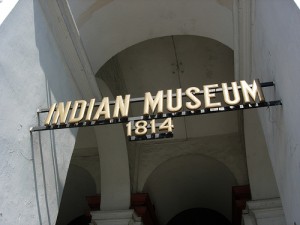Image Credit: Published Link
Lost in a long row of white buildings, amidst the madness of Chowringhee’s markets, is a nondescript two storied building. Except for the small Gold plated sign on it that says Indian Museum, 1814 there is nothing to suggest that it is the oldest museum in all of Asia and houses more than a hundred thousand artifacts. It is rightfully located in the then capital of British India, Calcutta (currently called Kolkata).
During my short stay in Calcutta, I was adamant about seeing as much of the city’s rich history as possible. My first stop was the Indian Museum, which is autonomously maintained under the Minister of Culture (a mystery that is uniquely Indian).
Upon entering the huge white structure, one gets a whiff of some needless bureaucracy – you have to have Rs 10 in change for the ticket, you have to go through bomb detectors that do not work and the like. However, what took the cake was that you are allowed to take your camera, wallet and other valuables inside the museum, but are required to deposit your bag. I, therefore, ended up depositing a small, empty bag at the counter and uneasily held on to plenty of my belongings as I toured the large museum for hours.
The museum has six sections comprising thirty five galleries of cultural and scientific artefacts namely art, archaeology, anthropology, geology, zoology and economic botany. Some of the most fascinating relics are dumped in these sections. The museum looked like a store house of historic objects, not an informative and creative display for people to enjoy and learn.
When Indians sing their own praises about 5000 years of history, it seems what they mean is tolerating decay of some never-to-be-found-again miniature Mughul paintings; not caring much about the anthropological remains of the rare tribes of India; And ignoring the 80,000 geological specimens and letting them grow dust.
In the far corner of the zoology section, I saw a man desperately trying to explain to his daughter the functions of mammals with a broken down specimen of a horseshoe bat.
Perhaps, the hunger for knowledge in an ordinary Indian does not equal the establishment’s desire to preserve organisations such as the Indian Museum. This extends to several public libraries across the country as well where books are treated as waste in a dump yard.
Civilizations like that of the Egyptians, Chinese and Indian have their histories to boast of that no other part of the world can. If anything, their sole effort should be to protect and nurture their fascinating histories.
Is the Ministry of Culture in New Delhi listening?
Published in: Easy Narrative
Published in: March 2012
Link: http://easynarrative.com/valuing-the-past/


